
1. Diagnostic tests
1.1. blood tests
1.2. upper endoscopy
1.3. upper GI series
1.4. CT scan
1.5. Biopsy
2. Treatment
2.1. Surgery
2.2. chemotherapy
2.3. radiation
3. Pathophysiology & Etiology
3.1. Multifactorial causes, but H.pylori accounts 80% of gastric cancer
3.1.1. atrophic and intestinal metaplasia are linked to development of gastric cancer
3.1.1.1. Duodenal reflux contains caustic bile salts that destroy mucosal barrier
3.1.1.2. insufficient acid secretion creates alkaline environment and allows bacteria to multiply and acts on nitrates, which damages DNA of mucosal cell
3.1.2. high salty food induces hypergastrinemia & endosgenous mutations which promotes epithelial cell proliferation and leads to parietal cell loss and gastric cancer progression
3.1.3. smoking and alcohol decrease production of prostaglandins that maintain gastric mucosal integrity
3.2. Infection of H.pylori
3.2.1. 1. causes gastric mucosal damage by secreting different enzyme products (urease, protease, phospolipase and acetaldehyde)
3.2.2. 2. disrupts gastric functions by urease-mediated myosin II activation
3.2.3. 3. leads to oxidative DNA damage through production of reactive oxygen and nitrogen species and suppresses the host antioxidant defense mechanisms
3.3. H.pylori induces chronic gastritis
3.3.1. 1. H.pylori contains a virulent factor of cytotoxin-associated gene A (cagA)
3.3.2. 2. During inflammatory process, cagA factor releases into gastric epithelial cells where it undergoes tyrosine phosphorylation by SRC family kinases
3.3.3. 3. The phosphorylated cagA then binds and activates SHP2, a phosphatase that transmits positive signals for cell growth and motility
3.3.4. 4. As a result, it activates growth factor receptors, releases of proinflammatory cytokines, and tumor promotors, which increases in proliferation of damaged cells, inhibits apoptosis and promotes invasion angiogenesis
4. Prevention
4.1. Dietary modifications
4.1.1. reduce intake of salt & salted food
4.1.2. Avoid food contain high nitrate level
4.1.3. Reduce intake of red meat
4.1.4. Increase intake of fruits & vegeables
4.2. Screening & eradication of H. pylori infection
5. Risk factors
5.1. Environmental
5.1.1. H.pylori (Helicobactor pylori) infection
5.1.2. dietary factors
5.1.2.1. high content salted food
5.1.2.2. foods contain high nitrates
5.1.3. alcohol consumption & cigarette smoking
5.1.4. occupational exposure
5.1.4.1. mining, farming
5.1.4.2. refining, fishing
5.1.4.3. asbestos, timber, rubber
5.2. Non-environmental
5.2.1. family history
5.2.2. blood type group A
5.2.3. pernicious enemia
5.3. Genetic
5.3.1. Familial contributes 10 to 15%
5.3.2. genomic instability
5.3.2.1. chromosomal instability- gain or loss of whole chromosome during seggregation, DNA damage
5.3.2.2. microsatellite instability- errors in DNA replication
5.3.3. genetic defect of CDH1 gene found in chromosome 16
6. Causative factors
6.1. H.pylori infection
6.2. severe gastritis
7. Clinical manifestations
7.1. Early stages
7.1.1. asymptomatic
7.1.2. loss appetite
7.1.3. malaise
7.1.4. weight loss
7.1.5. heartburn
7.2. Later stages
7.2.1. upper abdominal pain
7.2.2. nausea, vomiting
7.2.3. irregular bowel habits
7.2.4. anemia due to bleeding
